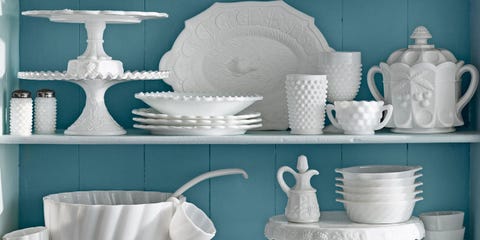Identify Green Depression Glass Pattern With Raised Bumps on Back

Opaque Glass originated in 16th century Venice and came in a variety of colors, including white, pink, yellow, blue, and brown. The white variety beloved today rose to prominence during the Victorian era, when it was coveted as an economic dead-ringer for porcelain. (The Victorians also get credit for coining the term "milk glass.") Its production and popularity waned during the Great Depression but saw a resurgence after World War II. Thanks to a frenzy of mass production during the 1950s and 1960s from companies such as Anchor Hocking, Fenton, and Westmoreland, the mid-century finds are readily available today—many for mere milk money. Here are some pretty pieces to add to your own collection.
Vases
In the 1950s and 1960s, milk glass vessels were florists' go-to. This small bud vase (1), valued at $5, showcases Stars and Bars, a popular pattern discontinued in 1965. Also of interest is this nubby style (2) that goes for $10 and sports the raised pattern known as Hobnail. Introduced by Fenton in 1939, the look quickly became synonymous with milk glass design. Less noteworthy vases can be found in lots of 5 to 10 for as little as $1 on eBay and Etsy.
Banana Stands Victorians wanted a dish for everything; bananas were no exception. This 1950s reproduction (1), used here as a flower display, features a lace edge and holds a value of $45. One from the early 1900s could fetch up to $100.
Pitchers Decorative pitchers recall a time when lingering around the dinner table was the norm. The striking owl (2), worth $125, is a wise investment thanks to pristine cabochon eyes. Less rare pitchers, like those alongside the owl, go for $40.
Cake Stands These stately pieces are the current "it" item among milk glass collectors and have high prices to show for it. This relatively rare Silver Crest cake plate by Fenton (3) has a thin wavy edge and fetches a sweet $75.
Punch Bowl A party staple of the 1960s, punch bowls are highly coveted by today's collectors. If paired with the original 12 cups, this bowl by glassmaker Hazel-Atlas (4) would bring in $50. Without the cups, you can scoop it for $25.
Cruets Made to hold oil and vinegar, cruets were popular during the Victorian era and saw a resurgence during the 1950s. This Westmoreland pourer (5) was part of a set that also came with a container and small tray. Alone the vessel is valued at $25; the full trio would command $50.
Plates Unlike other 20th-century tabletop collectibles such as Jadeite and Fiesta, actual milk glass dinnerware was never produced. Instead, the plates you see here were used as serving pieces or home deécor. Today, purely decorative plates, like this sought-after one featuring the face of George Washington (1), sell for $30. Those with flawless adornment (2) (painting floral or fruit motifs on milk glass was a popular hobby) have a rate of $20.
Covered Dishes Decorative sugar bowls and candy dishes were a staple on buffet tables throughout the 1900s. One of the most popular designs was Westmoreland's Paneled Grape. This 1940s version (3) is worth $25 thanks to its intact lid. Also of note is the Hen on a Nest (4) , which has been produced by virtually every milk glass manufacturer at some point. Those items were originally sold at grocery stores and contained mustard, but consumers continued to flock to the look long after they transported the condiment. This particular hen was produced in the 1950s by Indiana Glass and clucks in at $35.
Spot the Real Deal!
To verify your piece is a genuine antique (1960s and prior), look for the "Ring of Fire" by holding it up to a natural light source. Older milk glass was made with iridized salts and, therefore, should produce a halo of iridescent reds, blues, and greens in the sun.
Special thanks to Cynthia Bullard, president
of the National Milk Glass Collectors Society, nmgcs.org, for loaning us many of the
items in this story.
This content is created and maintained by a third party, and imported onto this page to help users provide their email addresses. You may be able to find more information about this and similar content at piano.io
Identify Green Depression Glass Pattern With Raised Bumps on Back
Source: https://www.countryliving.com/shopping/antiques/g2965/milk-glass-facts/
0 Response to "Identify Green Depression Glass Pattern With Raised Bumps on Back"
Post a Comment